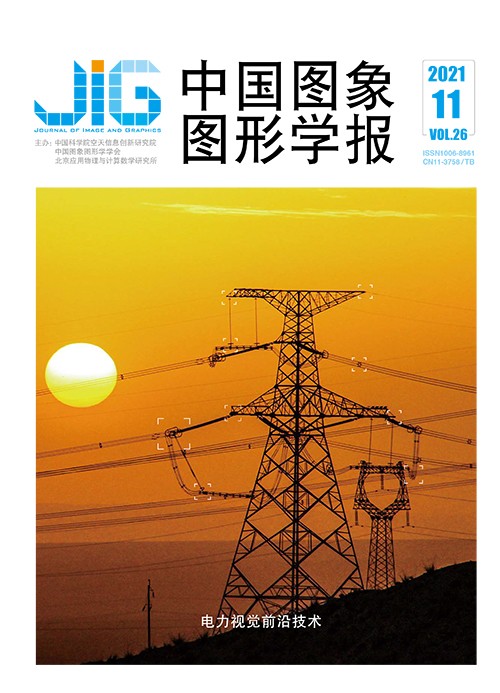
单幅植物叶片图像的3维重建
摘 要
目的 植物叶片形态复杂,在虚拟场景中很难真实表现。为了从信息量有限的单幅图像中恢复植物叶片的3维形状,本文基于从明暗恢复形状(shape from shading,SFS)的方法,利用亮度统计规律和植物形态特征恢复叶片的3维形状。方法 在SFS的基础上,设计基于图像骨架的距离场偏置加强表面细节;针对SFS对恢复宏观几何形状的不足,提出根据图像亮度统计分布选取控制点控制表面宏观形状变化,并利用叶片中轴的距离场约束恢复宏观几何形状,每种方法对于表面宏观几何形状恢复的权重基于恢复的反射图和输入图像间的相似度设定;将表面细节添加到宏观几何形状上得到目标对象的3维形状。结果 选取植物叶片图像进行实验,并与其他方法进行比较,实验结果表明本文方法增强了表面细节显示,并有明显的宏观几何形状变化。同时为了验证本文方法对其他物体表面细节恢复的适用性,分别对硬币和恐龙恢复表面细节,实验结果表明提出的增强表面细节的方法同样适用于其他物体。结论 针对单幅植物叶片图像的3维重建,在SFS的基础上提出了根据骨架特征加强表面细节,根据图像亮度统计分布和叶片中轴距离场约束共同恢复表面宏观几何形状的算法,实验结果验证了本文方法的可行性。
关键词
3D reconstruction of a single plant leaf image
Ren Feier, Liu Tong, Yang Long(College of Information Engineering, Northwest A&F University, Yangling 712100, China) Abstract
Objective In recent years, with the continuous improvement of computer hardware performance and the continuous in depth research of virtual plant modeling and landscape design in the fields of film and television and games, plant shape modeling has become possible and necessary. As one of the important organs of plants, leaves have complex physiological and morphological characteristics, which are difficult to represent in virtual scenes. Therefore, 3D reconstruction of plant leaves is a very challenging subject. Current 3D reconstruction methods have two main types. 1) External equipment such as laser or radar are used to measure the distance of the target by transmitting signals and then receiving the signals reflected by the target object to obtain the 3D shape of the surface. 2) Using the principle of binocular vision, two or more images are obtained from different perspectives in the same scene, then the 3D shape of the object is obtained according to the parallax between the images. The former requires the introduction of external equipment, which is costly and difficult to operate, whereas the latter needs to detect and match the feature points between the acquired image sequences due to the reconstruction based on multiple images. The acquisition of a single image is simple, and the problem of feature matching of multiple images is eliminated. However, due to the less information contained in a single image and to recover the 3D shape of plant leaves from the limited information, this paper is based on the method of the shape from shading (SFS) and preprocesses the image to add a priori to the 3D shape estimation. The brightness statistic information obtained from the image and the prior information of plant morphological characteristics are used to recover the final 3D shape of the leaf. Method When restoring the 3D shape of a single plant leaf image, the restoration of the surface shape is divided into two aspects:surface detail and surface macroscopic geometric shape. First, based on SFS, a distance field offset algorithm is designed according to the image skeleton to enhance the surface details of 3D shapes. The edge detection method is used to detect the leaf veins as the skeleton of the image, and the distance from the image skeleton is used as the constraint of the SFS minimization method to enhance the surface detail display. Then, to address the deficiencies of SFS in recovering the macroscopic geometric shape, various factors that affect the macroscopic geometric shape are considered, and the characteristics of leaf surface unevenness and curvature are finally realized. Selecting control points according to the statistical distribution of image brightness is proposed to control the change of the surface macroscopic geometric shape, and the distance field constraint of the blade central axis is used to restore the macroscopic geometric shape. According to the brightness statistics, the image is divided into bright-dark areas, the centroid of the unconnected areas of the bright and dark regions is used as the control point, and the cubic Bezier surface is used to generate the concave and convex characteristics of the blade surface. The overall bending of the blade can be estimated based on the distance from each point of the blade to the central axis because most blades have a certain degree of bending about the central axis and the curvature at the central axis changes the most. The two weights for the restoration of the surface macroscopic geometric shape are set based on the similarity between the restored reflection map and the input image, and the surface details are finally added to the macroscopic geometric shape to obtain the final 3D shape of the target object. Result Plant leaf images are selected for experiments, and their 3D restoration results are compared with those of other methods (including Tsai linear approach, Zheng minimization approach, SIRFS(shape, illumination, and reflectance from shading), and variational approach). Experimental results show that the method proposed enhances the display of surface details and has evident changes in macroscopic geometric shape. To verify the applicability of the method in the restoration of object surface details, namely, recovering the surface details of coins and dinosaurs, the experimental results prove that the proposed method of enhancing surface details is also applicable to other objects. In addition, using the ratio of error to information entropy is proposed to describe the effect of 3D reconstruction of the target. Error describes the accuracy of restoration, and information entropy describes the richness of information. The larger the entropy is, the greater the difference between the depth of restoration, which means larger surface macroscopic geometry changes. When the error is smaller and the information entropy is larger, the ratio of error to information entropy is smaller and the recovery effect is better. Conclusion To address the 3D reconstruction problem of a single plant leaf image, decomposing the problem into two aspects is proposed:surface details and macroscopic geometric shape. Based on SFS, the surface details are enhanced according to the skeleton feature, the surface macroscopic geometric shape is jointly restored using the statistical distribution of image brightness and the axial distance field constraints of the leaves, the final 3D shape is obtained by combining the surface details and the macroscopic geometric shape, and the feasibility of the proposed method is verified by multiple sets of experiments.
Keywords
3D restoration shape from shading(SFS) single image image skeleton image brightness statistics distance field constraint
|



 中国图象图形学报 │ 京ICP备05080539号-4 │ 本系统由
中国图象图形学报 │ 京ICP备05080539号-4 │ 本系统由